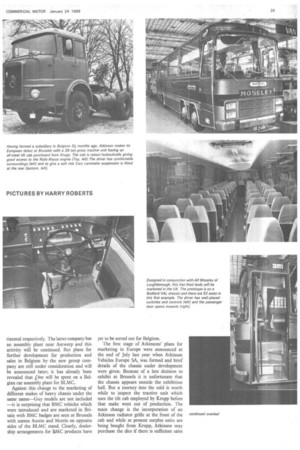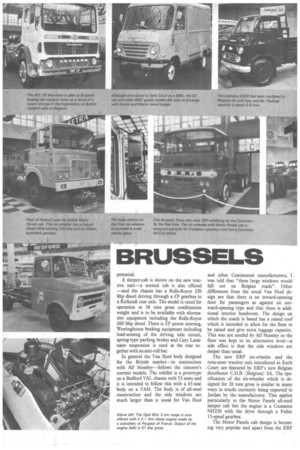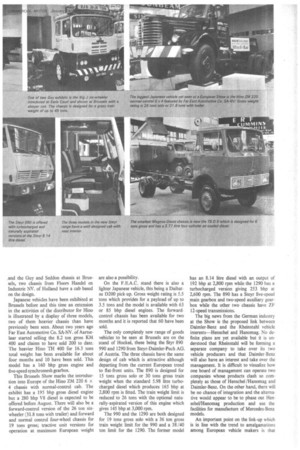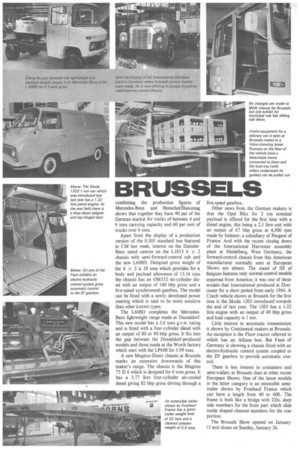the Brussels show
Page 40

Page 41

Page 42

Page 43

Page 44

If you've noticed an error in this article please click here to report it so we can fix it.
THE Brussels Show is always given a lot of attention by British vehicle makers as Belgium is one of the Common Market countries most receptive to trucks and buses from this country. With no manufacturer of its own Belgium is an open house and helped by assembly in Holland Bedfords do particularly well there. For the rest, high tariffs restrict sales of imported British chassis but with local assembly the situation can be helped.
Potentially, the country is an important one for the future of commercial vehicle exports from Britain and it is no doubt this fact that has led the British Leyland Motor Corporation to make a big effort at the Show. And as well as all the regular vehicle exhibitors such as Commer, Dodge, Ford and Bedford, and Seddon models shown by Hocke, there are Atkinson and ERF, the last two companies having chosen this Show as the stepping-off point for their efforts at selling in Europe.
The Atkinson and ERE models shown have been designed specifically for the European market but of particular interest to the British user is a Van Hool coach designed for Britain and to be marketed here by Alf Moseley and Sons Ltd. of Loughborough. There are new models from German and Austrian manufacturers also, together with a number of interesting detail changes. And from Japan there are heavier Hino chassis than have been exhibited in Europe before.
With all its different makes seen together at a Show for the first time, the BLMC display is large and impressive. This is the first time that the higher-output--272 bhp—AEC VS diesel has been publicized and as well as being fitted in the Guy Conquest passenger chassis this power unit is employed in goods exhibits on the joint stand. As recorded in the last week's issue there are examples of AEC's earlier range with a new Bollekens cab but AEC goods chassis and the Sabre coach chassis that appeared for the first time at Earls Court are displayed under the Leyland name.
This will be the future policy for Europe and it coincides with the formation of British Leyland Group SA to replace the previous Leyland and AEC distribution companies of Brossel Were and AEC Con
tinental respectively. The latter company has an assembly plant near Antwerp and this activity will be continued. But plans for further development for production and sales in Belgium by the new group company are still under consideration and will be announced later; it has already been revealed that Pl-in will be spent on a Belgian car assembly plant for BLMC.
Against this change to the marketing of different makes of heavy chassis under the same name Guy models are not included —it is surprising that BMC vehicles which were introduced and are marketed in Britain with BMC badges are seen at Brussels with names Austin and Morris on opposite sides of the BLMC stand. Clearly, dealership arrangements for BMC products have yet to be sorted out for Belgium.
The first stage of Atkinsons' plans for marketing in Europe were announced at the end of July last year when Atkinson Vehicles Europe SA, was formed and brief details of the chassis under development were given. Because of a late decision to exhibit at Brussels it is unfortunate that the chassis appears outside the exhibition hall. But a journey into the cold is worth while to inspect the tractive unit which uses the tilt cab employed by Krupp before that make went out of production. The main change is the incorporation of an Atkinson radiator grille at the front of the cab and while at present surplus units are being bought from Krupp, Atkinson may purchase the dies if there is sufficient sales potential.
A sleeper-cab is shown on the new tractive unit—a normal cab is also offered —and the chassis has a Rolls-Royce 220 bhp diesel driving through a ZF gearbox to a Kirkstall rear axle. The model is rated for operation at 38 tons gross combination weight and is to be available with alternative equipment including the Rolls-Royce 260 bhp diesel. There is ZF power steering, Westinghouse braking equipment including load-sensing of the driving axle circuit, spring-type parking brakes and Cary Laminaire suspension is used at the rear together with an anti-roll bar.
In general the Van Hool body designed for the British market—in conjunction with Alf Moseley—follows the concern's current models. The exhibit is a prototype on a Bedford VAL chassis with 53 seats and it is intended to follow this with a 45-seat body on a VAM. The body is of all-steel construction and the side windows are much larger than is usual for Van Hool
Above left: The Opel Blitz 2-ton range is now offered with a 2.1 litre diesel engine made by a subsidiary of Peugeot of France. Output of the engine (left) is 67 bhp gross.
and other Continental manufacturers; I was told that "these large windows would fall out on Belgian roads". Other differences from the usual Van Hool design are that there is an inward-opening door for passengers as against an outward-opening type and that there is additional interior headroom. The design on which the coach is based has a raised roof. which is intended to allow for the floor to be raised and give extra luggage capacity. This was not needed by Alf Moseley so the floor was kept to its alternative levet—a side effect is that the side windows are deeper than usual.
The new ERF six-wheeler and the twin-steer tractive unit introduced at Earls Court are featured by ERF's new Belgian distributor C.D.S. (Belgium) SA. The specification of the six-wheeler which is designed for 26 tons gross is similar in many ways to trucks currently being exported to Jordan by the manufacturer. This applies particularly to the Motor Panels all-steel sleeper cab but the engine is a Cummins NH220 with the drive through a Fuller 15-speed gearbox.
The Motor Panels cab design is becoming very popular and apart from the ERF .and the Guy and Seddon chassis at Brussels, two chassis from Floors Handel en Industrie NV. of Holland have a cab based on the design.
Japanese vehicles have been exhibited at Brussels before and this time an extension in the activities of the distributor for Hino is illustrated by a display of three models, two of them heavier chassis than have previously been seen. About two years ago Far East Automotive Co. SA-NV. of Aartselaar started selling the 8.2 ton gross KM 400 and claims to have sold 200 to date. The heavier Hino TH 400 for 163 tons total weight has been available for about four months and 10 have been sold. This model has a 160 bhp gross engine and five-speed synchromesh gearbox.
This Brussels Show marks the introduction into Europe of the Hino ZM 220 6 x 4 chassis with normal-control cab. The exhibit has .a 195 bhp gross diesel engine but a 280 bhp V8 diesel is expected to be offered before August. There will also be a forward-control version of the 26 ton sixwheeler (31.8 tons with trailer) and forward and normal control four-wheel chassis for 19 tons gross; tractive unit versions for operation at maximum European weight are also a possibility.
On the F.E.A.C. stand there is also a lighter Japanese vehicle, this being a Daihatsu D200 pick-up. Gross weight rating is 5.5 tons which provides for a payload of up to 3.5 tons and the model is available with 63 or 85 bhp diesel engines. The forwardcontrol chassis has been available for two months and it is reported that 60 have been sold.
The only completely new range of goods vehicles to be seen at Brussels are on the stand of Hockee, these being the Styr 890 990 and 1290 from Steyr-Daimler-Puch AG. of Austria. The three chassis have the same design of cab which is attractive although departing from the current European trend to flat-front units. The 890 is designed for 15 tons gross solo or 30 tons gross train weight when the standard 5.98 litre turbocharged diesel which produces 165 bhp at 2,800 rpm is fitted. The train weight limit is reduced to 26 tons with the optional naturally-aspirated version of this engine which gives 145 bhp at 3,000 rpm.
The 990 and the 1290 are both designed for 19 tons gross solo with a 36 ton gross train weight limit for the 990 and a 38/40 ton limit for the 1290. The former model
has an 8.14 litre diesel with an output of 192 bhp at 2,800 rpm while the 1290 has a turbocharged version giving 253 bhp at 2,600 rpm. The 890 has a Steyr five-speed main gearbox and two-speed auxiliary gearbox while the other two chassis have ZE, 12-speed transmissions.
The big news from the German industry at the Show is the proposed link between Daimler-Benz and the Rheinstahl vehicle interests—Henschel and Hanomag. No definite plans are yet available but it is understood that Rheinstahl will be forming a separate company to take over its two vehicle producers and that Daimler-Benz will also have an interest and take over the management. It is difficult to visualize how one board of management can operate two companies whose products clash so completely as those of Henschel /Hanomag and Daimler-Benz. On the other hand, there will be no chance of integration and the alternative would appear to be to phase out HenseheVHanomag production and use the facilities for manufacture of Mercedes-Benz models.
An important point on the link-up which is in line with the trend to amalgamations among European vehicle makers is that combining the production figures of Mercedes-Benz and Henschel/Hanomag shows that together they have 90 per of the German market for trucks of between 4 and 6 tons carrying capacity and 60 per cent of trucks over 6 tons.
Apart from the display of a production version of the 0.305 standard bus featured in CM last week, interest on the DaimlerBenz stand centres on the L1813 6 X 2 chassis with semi-forward-control cab and the new L608D. Designed gross weight of the 6 X 2 is 18 tons which provides for a body and payload allowance of 13.16 tons the chassis has an 0M352 six-cylinder diesel with an output of 140 bhp gross and a five-speed synchromesh gearbox. The model can be fitted with a newly developed power steering which is said to be more sensitive than other known types.
The L608D completes the MercedesBenz lightweight range made at Dusseldorf. This new model has a 5.6 tons g.v.w. rating and is fitted with a four-cylinder diesel with an output of 80 or 90 bhp gross. It fits into the gap between the Dusseldorf-produced models and those made at the Worth factory which start with the LP608 for 5.99 tons.
A new Magirus-Deutz chassis at Brussels marks an extension downwards of this maker's range. The chassis is the Magirus 75 D 6 which is designed for 6 tons gross. It has a 3.77 litre four-cylinder air-cooled diesel giving 82 bhp gross driving through a five-speed gearbox.
Other news from the German makers is that the Opel Blitz for 2 ton nominal payload is offered for the first time with a diesel engine, this being a 2.1 litre unit with an output of 67 bhp gross at 4,500 rpm made by Indenor, a subsidiary of Peugeot of France. And with the recent closing down of the International Harvester assembly plant at Heidelberg, West Germany, the forward-control chassis from this American manufacturer normally seen at European Shows are absent. The stand of IH of Belgium features only normal-control models imported from America; it was one of these models that International produced at Doncaster for a short period from early 1966. A Czech vehicle shown at Brussels for the first time is the Skoda 1203 introduced towards the end of last year. The. 1203 has a 1.22 litre engine with an output of 49 bhp gross and load capacity is 1 ton.
Little interest in automatic transmission is shown by Continental makers at Brussels. An exception is the Floor tractor referred to which has an Allison box. But Faun of Germany is showing a chassis fitted with an electro-hydraulic control system coupled to the ZF gearbox to provide automatic control.
There is less interest in containers and semi-trailers at Brussels than at other recent European Shows. One of the latest models in the latter category is an extensible semitrailer shown by Fruehauf France which can have a length from 40 to 60ft. The frame is built like a bridge with 22in, deep side members for the front part which slide inside shaped channel members for the rear portion.
The Brussels Show opened on January 15 and closes on Sunday, January 26.








































































































